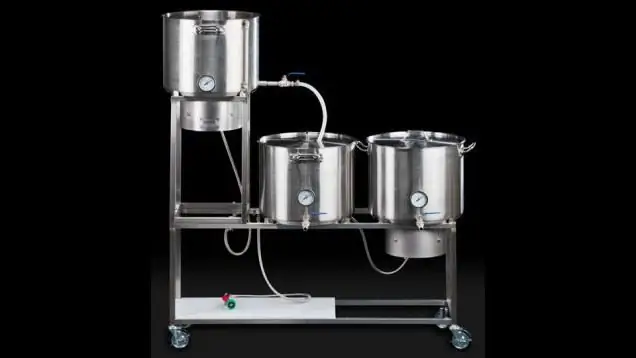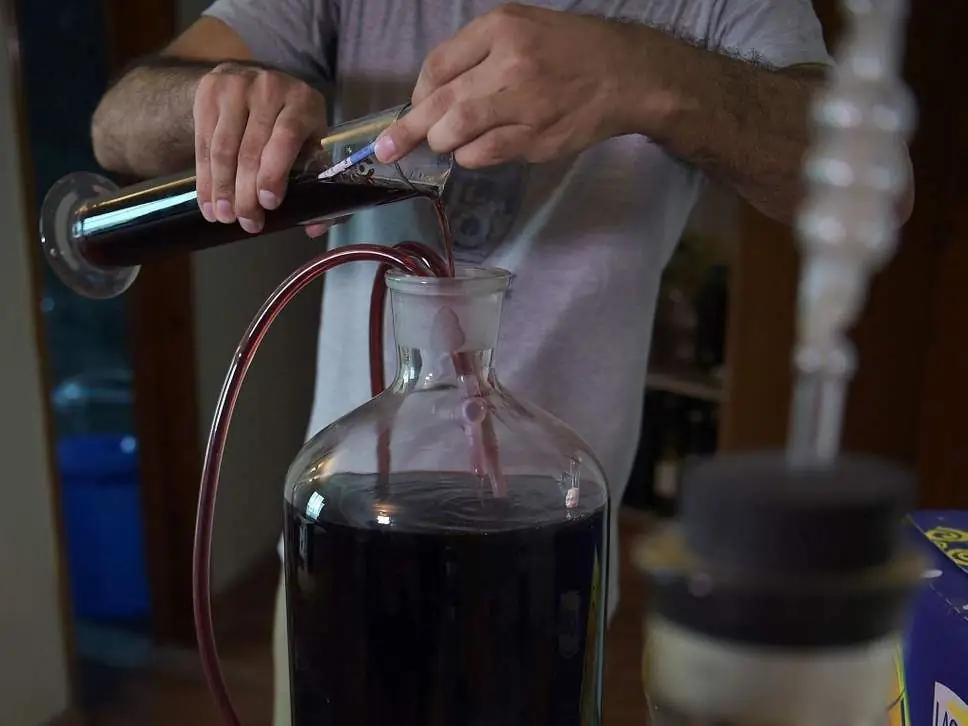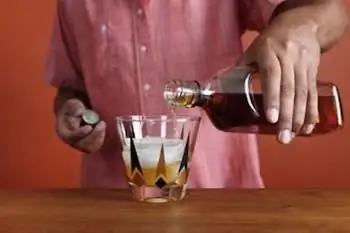2025 Author: Isabella Gilson | [email protected]. Last modified: 2025-01-23 12:50:39
Cognac is a noble drink that is quite difficult to make at home. Homemade cognac recipes, based on the use of ordinary ethyl alcohol as a raw material, make it possible to obtain only a crude fake. Only by making a real cognac distillate, you can enjoy a fragrant bouquet without fear for the quality of the consumed alcoholic beverage.
What is cognac distillate?
Cognac distillate is made from dry white grape wines of certain varieties with the obligatory observance of all the rules of distillation and aging. Only with strict observance of all production conditions will cognac acquire its characteristic color, bouquet and taste.
Let's consider the steps of the distillate production process:
- Preparation of wine materials, including the cultivation and harvesting of grape varieties with a minimum sugar content.
- Getting and preparing grape juicemust.
- Fermentation of grape must.
- Primary and secondary distillation of the resulting wine with the separation of the middle fraction.

The efforts spent on production will pay off, because the cost of 1 liter of home-made cognac distillate is significantly lower than the price of cognac in the store. The result of the correct passage of all stages will be homemade cognac, which is nice to drink on your own or treat your friends.
Cognac distillate or cognac spirit - which is better?
Nothing is better, they are different names for the same product. According to the latest national standard (GOST), cognac distillate was introduced instead of cognac spirit that existed in the legislation until 2012.
It should be noted that the description of the cognac spirit production technology is identical to the standard for the production of cognac distillate.
Failure to comply with the requirements for production technology increases the amount of harmful substances, including fusel oil, which is included in cognac distillate, the hazard class of which is defined as the third.
Grape varieties for cognac distillate production
Cognac distillate can only be obtained from certain varieties of sour grapes. Their distinguishing feature is their low sugar content. In France, Folle Blanche, Colombard and Ugni Blanc are used for this purpose, with particularly intense and persistent aromas.
So what kind of grapes to choose for making your cognac? It shouldbe fruits of white, less often pink varieties with clear juice without nutmeg aftertaste. Grown everywhere in the south of Russia, Isabella is not suitable as a wine material for the production of cognac due to the low yield of the product.

The most suitable varieties were recognized by the Institute of Winemaking and Viticulture:
- Grushevsky white;
- Kunlean;
- Bianca;
- Swim;
- Aligote;
- Scarlet Tersky.
These grape varieties at the technical maturity stage have the right sugar content and acidity, as well as heat resistance and high juice content, necessary for the production of must by the drip method.
Preparation of wine materials for cognac distillate
Search the harvested grapes, removing spoiled fruits. It is impossible to wash the grapes because of the yeast cultures on the skin that are necessary for fermentation. To obtain juice, crush the grapes along with the seeds.
Pour the resulting juice together with the pulp into an enameled vat and sprinkle with a little sugar if the berries are slightly underripe. Within two weeks, natural yeast forms on the surface and the fermentation process starts. If fermentation is not too active, add wine yeast. Seal the container tightly and place in a warm place. Remember to stir once a day.

After 1-2 weeks, measure the strength of the young wine with an alcoholometer. If it shows 11-12%, drain it by straining the pulp throughgauze. Long exposure of wine is not recommended due to the possibility of Madeira flavors.
Primary distillation
Cognac distillate is produced from young white wine by double distillation. Pass the wine material obtained as a result of fermentation through a distiller to produce raw alcohol. It is also very important at the stage of the first distillation to be able to correctly separate the middle fraction from the head and tail.
The result of the primary distillation will be raw distillate with a strength of 25-30% and stillage.

It is permissible to leave the middle fraction with the tail for re-distillation. In this case, it is necessary to lower the strength of the raw alcohol by diluting it with pure water before the re-distillation process.
Second distillation
Improving the quality of the product is achieved through repeated distillation, during which it is also necessary to separate the fractions and cut off the central one from them.
The head fraction has a sharp unpleasant odor and has a strength of about 80-85%. About 3% of raw alcohol and up to half an hour of working time are spent on its production.
The central fraction, which is the desired cognac spirit, is cut off as the pungent odor weakens. Cut-off is also made based on the strength of the product: the start of selection is 78%, the end is 58%, to avoid unpleasant tail tones in the distillate.

As the strength of the produced product decreases from 50% and below, the cut-off stage is suitabletail fraction. The third fraction has a significant volume and often takes from 40 to 50 percent of the total raw alcohol. The tail can be left for further distillation.
The result of secondary distillation and separation of the middle fraction will be high-quality cognac distillate - a colorless transparent liquid with a taste of ethyl alcohol and a pronounced wine aroma, suitable for further aging.
Recommended:
Technology for making whiskey at home

Surely there is no such alcoholic product that home craftsmen could not prepare in a handicraft way. Whiskey is one such type of liquor. Of course, the taste of "living water", as this drink is also called, is influenced by the place where it is made. However, according to experts, the technology for making whiskey in different countries is almost the same. You can make this alcoholic drink at home. You will learn about the technology of making whiskey at home from this article
Recipes for making dumplings at home

What hostess doesn't know how to cook dumplings? To date, there are many recipes for preparing this dish. The base is a classic dough for making homemade noodles. The filling can be varied - pork, beef, chicken, minced lamb, to which various spices are added
Home breweries: reviews. Home mini-brewery. Home Brewery: Recipes

What makes homebreweries so good? Reviews of those who have already used these machines for making beer, various important nuances and advantages of such an acquisition - all this can be read in the text below
Alcoholic drinks at home: recipes for making wine, vodka, cognac, moonshine

Homemade alcoholic drinks are loved and respected by many people. To a greater extent, this is due to the fact that they are tasty, safe and inexpensive. In addition, many recipes for alcoholic beverages at home are quite simple and even a beginner can handle cooking. What alcohol can be made at home? Recipes and cooking nuances are presented in the article
Whiskey at home. Making whiskey at home

This is a world-famous alcoholic drink, which is considered noble and prestigious, it is distinguished from others by its unique taste and special preparation technology. You can make a variety of different cocktails that will certainly appeal to your taste. Everyone has ever dreamed of trying it, at least just a little

